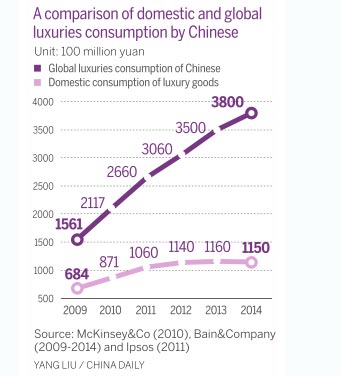The rise and rise of the fashion queen
 |
|
A comparison of domestic and global luxuries consumption by Chinese. Yang Liu/China Daily |
"Every morning Brown (then in her mid-70s) arrived at the office very smartly dressed and absolutely switched on," Su says. "In China it was extremely rare for a woman of that age to dress up like that every day and to be so committed to her work."
Over the next two decades Su would be both a spectator and player in the great changes that took place in the Chinese fashion industry, flitting between Beijing, Shanghai, New York, London and Paris and seated in the front row of shows of the world's leading designers or fashion houses.
The seeds of that initial enthusiasm in the early 1980s were sown in 1979 when the French designer Pierre Cardin brought 12 foreign models to give a runway show in Beijing. He was the first Western designer to visit China since 1949, and Pierre Cardin became the first foreign brand to enter the country.
In 1984 10 arts institutes including the Central Academy of Arts in Beijing, for the first time recruited models publicly. According to Beijing Evening News, 171 people applied-and many wished to remain anonymous. Before long the first model pageant was held in Beijing and the country had its first professional models.
In 1992 Louis Vuitton opened the door for the world of elegance and luxury goods with its first store in China, and the likes of Armani, Chanel, Dior and Gucci soon followed suit.
When first lady Peng Liyuan arrived in Moscow in March 2013 it was obvious that China had indeed caught that wave. Jaws dropped as Peng, with President Xi Jinping on his first state visit to Russia, emerged from the aircraft, elegantly dressed in a dark navy overcoat, a light turquoise silk scarf and handbag, which, predictably enough, soon become top search items on China's biggest shopping website, Taobao.com.
In a way that appearance in Moscow of Peng Liyuan was like a coming out for the fashion designer Ma Ke, who for more than 10 years had dressed Peng, but whose renown was largely restricted to fashion circles.
Ma, now 45, had created her own label in Guangzhou after graduating from Suzhou Silk Institute in 1992 and over the years has won many industry accolades. Ma has also set the trend for Chinese fashion designers in achieving worldwide acclaim, and many of those who wish to emulate her have taken up studies in top design schools overseas.
However, the story of China and its embrace of fashion and the good things in life is more about the masses than about these famous names, and that can be seen in the love of Chinese for luxury goods.
















